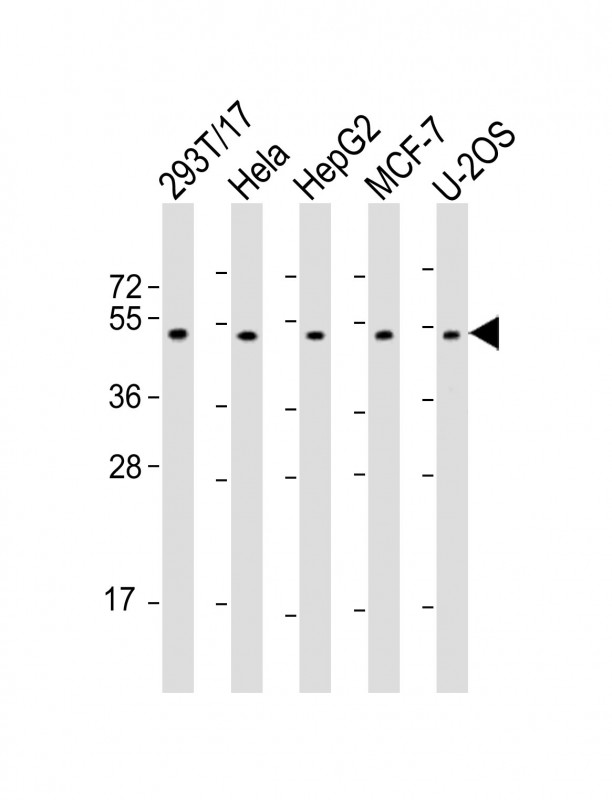
| WB | 1/2000 | Human,Mouse,Rat |
| IF | 咨询技术 | Human,Mouse,Rat |
| IHC | 咨询技术 | Human,Mouse,Rat |
| ICC | 技术咨询 | Human,Mouse,Rat |
| FCM | 咨询技术 | Human,Mouse,Rat |
| Elisa | 咨询技术 | Human,Mouse,Rat |
| Aliases | Zinc finger protein PLAGL1, Lost on transformation 1, LOT-1, Pleiomorphic adenoma-like protein 1, Tumor suppressor ZAC, PLAGL1, LOT1, ZAC |
| Entrez GeneID | 5325 |
| WB Predicted band size | 50.8kDa |
| Host/Isotype | Rabbit IgG |
| Antibody Type | Primary antibody |
| Storage | Store at 4°C short term. Aliquot and store at -20°C long term. Avoid freeze/thaw cycles. |
| Species Reactivity | Human |
| Immunogen | This PLAGL1 antibody is generated from a rabbit immunized with a KLH conjugated synthetic peptide between 112-146 amino acids from human PLAGL1. |
+ +
1. **"PLAGL1 regulates a tumor suppressor network in human bladder cancer"**
- Authors: Li, X., et al.
- Summary:该研究利用PLAGL1 (N-Term)抗体通过免疫沉淀和Western blot分析,揭示了PLAGL1在膀胱癌中通过调控p53和PTEN通路抑制肿瘤生长的分子机制。
2. **"Epigenetic silencing of PLAGL1 in colorectal cancer promotes Warburg效应"**
- Authors: Wang, Y., et al.
- Summary:通过PLAGL1 (N-Term)抗体的免疫组化实验,研究发现结直肠癌中PLAGL1启动子高甲基化导致其表达下调,进而增强糖酵解并促进肿瘤进展。
3. **"PLAGL1 modulates DNA damage response in pancreatic β-cells"**
- Authors: Garcia-Herrero, C.M., et al.
- Summary:使用PLAGL1 (N-Term)抗体进行染色质免疫共沉淀(ChIP),发现PLAGL1通过结合ATM激酶启动子区域调控β细胞的DNA损伤修复能力。
4. **"Zac1 (PLAGL1) induces apoptosis through JNK pathway in neuroblastoma"**
- Authors: Varrault, A., et al.
- Summary:通过PLAGL1 (N-Term)抗体的Western blot和免疫荧光实验,验证了PLAGL1在神经母细胞瘤中激活JNK信号通路并诱导caspase依赖性凋亡的作用。
The PLAGL1 (N-Term) antibody is designed to target the N-terminal region of the pleomorphic adenoma gene-like 1 (PLAGL1) protein, a zinc finger transcription factor encoded by the PLAGL1 gene. PLAGL1. also known as ZAC or LOT1. plays critical roles in regulating cell cycle progression, apoptosis, and genomic imprinting. It is implicated in various physiological processes, including embryonic development, endocrine function, and tumor suppression. Dysregulation of PLAGL1 has been linked to growth disorders (e.g., transient neonatal diabetes mellitus and Russell-Silver syndrome) and cancers, where it often acts as a tumor suppressor by modulating genes involved in proliferation and apoptosis.
The N-terminal region of PLAGL1 contains key functional domains responsible for DNA binding and protein-protein interactions, making it a focal area for studying transcriptional regulation. The PLAGL1 (N-Term) antibody is commonly utilized in techniques like Western blotting, immunohistochemistry, and immunofluorescence to detect PLAGL1 expression levels, subcellular localization, and interactions in cellular or tissue samples. Its specificity for the N-terminal epitope ensures recognition of full-length or truncated variants, aiding research on PLAGL1’s role in diseases and developmental pathways. Validation of this antibody typically includes verification in PLAGL1-overexpressing or knockout models to confirm sensitivity and minimal cross-reactivity.
×